Raiatea
Raiatea (Tahitian: Ra'iātea) is the second largest of the Society Islands, after Tahiti, in French Polynesia. The island is widely regarded as the "centre" of the eastern islands in ancient Polynesia and it is likely that the organised migrations to the Hawaiian Islands, New Zealand and other parts of East Polynesia started at Raiatea.
| Native name: Ra'iātea | |
|---|---|
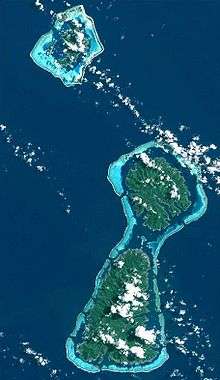 | |
| Geography | |
| Location | Pacific Ocean |
| Coordinates | 16°49′S 151°27′W |
| Archipelago | Society Islands |
| Major islands | Raiatea |
| Area | 167.7 km2 (64.7 sq mi) |
| Highest elevation | 1,017 m (3,337 ft) |
| Highest point | Mount Tefatua |
| Administration | |
| Overseas collectivity | French Polynesia |
| Capital and largest city | Uturoa [1] (pop. 3,778) |
| Demographics | |
| Population | 12,545[2] |
| Pop. density | 72/km2 (186/sq mi) |
A traditional name for the island is Havai'i, homeland of the Māori people.[3] Situated on the southeast coast is the historical Taputapuatea marae, which was established by 1000 AD.
The main township on Raiatea is Uturoa, the administrative centre for the Leeward Islands (French Îles Sous-le-vent). There are also colleges which serve as the main educational location for secondary schools for students from the regional islands of Bora Bora, Tahaa, Huahine and Maupiti.
Etymology
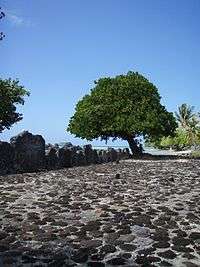
The Tahitian language name Ra'iātea means bright sky. "Ulitea" is an obsolete transcription commonly used in the 19th century. The term recurs elsewhere in Polynesia as a local place name - on Rarotonga (Rangiatea), in New Zealand (Rangiātea), and on the Hawaiian islands of Hawai'i and O'ahu (Laniākea).
The extinct Raiatea starling inhabited the island; there is only one drawing of it in the world - in the Natural History Museum, London.
Geography and population
The islands of Raiatea and Tahaa are enclosed by a single coral reef, and may once have been a single island. Raiatea is both the largest and most populated island in the Leeward Islands, with a land area of 167.7 km2 (64.7 sq mi) and a total population of 12,024 inhabitants at the August 2007 census. The population density is 72 inhabitants per km². The largest commune of Raiatea is Uturoa on the north side of Raiatea and has a population of nearly 10,000.
History
The Polynesian navigator Tupaia, who sailed with explorer James Cook, was born in Raiatea around 1725. Cook visited Raiatea in 1769 and again in 1773-1774.[3]:214–218,284–291,315–318 He named the island "Ulitea".[4] Omai (c.1751-1780), another young man from Raiatea, travelled with European explorers to London in 1774 and also served as an interpreter to Captain Cook on his second and third journeys.
King Tamatoa VI was the last monarch, reigning from 1884-1888.
Transportation
Raiatea has a small road that runs around the entire island. Raiatea Airport is an airport in Uturoa.
Administration
The island is divided into three administration communes (municipalities):
These three communes are inside the administrative subdivision of the Leeward Islands.
Economy
The island economy is mainly agricultural with exports of vanilla, pineapple and coconut. The plant Nono (or noni) (Morinda citrifolia) is also grown. Fa'aroa Valley is a large and important agricultural region with the rural economy and the cultivation of vanilla supported by a local research facility. Pearl farming is also an important industry while farming cattle, sheep and pigs has recently decreased. There is less tourism compared to the other islands in the archipelago. The local tourist infrastructure comprises boarding houses, two marinas, a four star hotel, The Hawaiki Nui and a port for visiting cruise ships. There is also a fledgling local industry in the maintenance of yachts and shipbuilding. The main source of employment is the island's public service and the consumer market.
Gallery
.jpg) View of Raiatea island from a plane.
View of Raiatea island from a plane.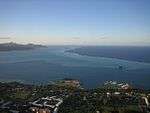 Uturoa, seen from Tapioi
Uturoa, seen from Tapioi- An island south of Raiatea with Huahine island in the background
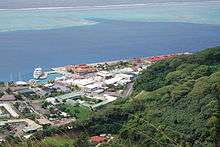 Looking down at the town of Uturoa and ocean.
Looking down at the town of Uturoa and ocean.- Ship at Raiatea.
 Another view of Taputapuatea marae.
Another view of Taputapuatea marae.- View of Pora Pora from Raiatea.
- Vanilla pods drying in the sun.
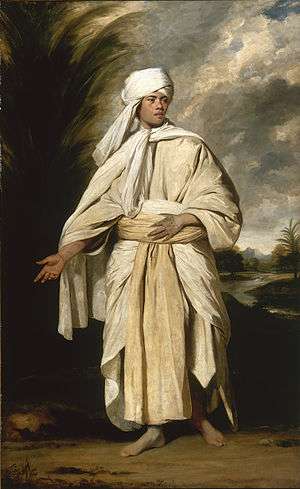 Portrait of Omai, oil on canvas, by Sir Joshua Reynolds, 1776
Portrait of Omai, oil on canvas, by Sir Joshua Reynolds, 1776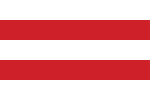 Flag of the Kingdom of Raiatea from 1847 to 1880
Flag of the Kingdom of Raiatea from 1847 to 1880
References
- "Raiatea a unique natural heritage". e-Tahiti Travel. Archived from the original on 2007-12-13. Retrieved 2019-12-22.
- Institut Statistique de Polynésie Française (ISPF). "Recensement de la population 2007" (PDF) (in French). Archived from the original (PDF) on 2007-12-03. Retrieved 2007-12-02.
- Salmond, Anne (2010). Aphrodite's Island. Berkeley: University of California Press. pp. 227-228. ISBN 9780520261143.
- Ellis, William (1830). Polynesian Researches, During a Residence of Nearly Six Years in the South Sea Islands, including Descriptions of the Natural History and Scenery of the Islands, with Remarks on the History, Mythology, Traditions, Government, Arts, Manners, and Customs of the Inhabitants. II. London: Fisher, Son, & Jackson. p. 6. Retrieved 2020-01-23.
Ioretea, the Ulitea of Captain Cook, or, as it is now more frequently called by the natives, Raiatea, is the largest of the Society Islands.